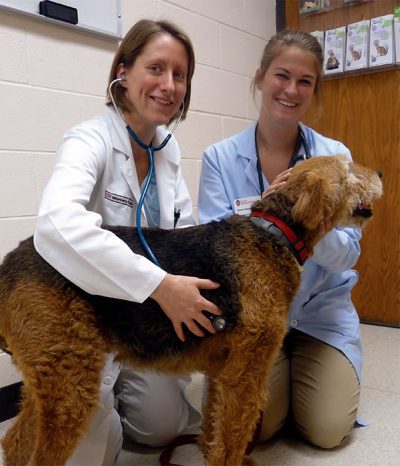A path from specialization in internal medicine to a focus on primary care

Finding Inspiration
When Elizabeth Alvarez (DVM ’03) graduated, her plan was to pursue a career in internal medicine. She is now section head and clinical instructor in the Primary Care Service at the University of Wisconsin-Madison School of Veterinary Medicine (UW).
“I felt so drawn to internal medicine because of great teachers,” says Alvarez. “Dr. (Stephen) Carey and Dr. (Coretta) Patterson were energetic, approachable, and easy to work with. It really inspired me.”
Alvarez has not become an internist, but the passion for teaching and learning that she developed at MSU have been guiding forces throughout.
Alvarez worked in private practices in Seattle and Chicago before coming to UW. She moved to a number of increasingly specialized practices, driven by a desire to be challenged, and she wanted to be closer to her patients’ full cycle of care. After another shift to a smaller, more specialized private practice failed to fulfill that sense of something missing, she decided to pursue specialization and interned at a practice outside of Seattle, where she was living with her husband.
“I still had aspirations to specialize in internal medicine and had applied for a residency in the Chicago area,” she says. “Then, an intern mate told me about the primary care opening in Madison.”
Alvarez was offered both positions.
“I had to choose to pursue my dream in internal medicine, or to accept what was truly an extraordinary opportunity at the university,” recalls Alvarez. “And I needed to do this with my husband and in the context of our plans for starting a family.”
After what she describes as some serious soul searching, she and her husband chose to move to Madison, where they now live with a three-year-old daughter, a one-year-old son, and a cat that has lived with her as she’s made her way living and working through several states.
Pursuing knowledge
(and passing it on)
Alvarez has found in the Primary Care Service at UW a continuing learning experience, which is supported by close proximity to specialists. Through her relationships with specialist services, she is also involved in her patients’ cycle of care.
“That sense that something is missing hasn’t surfaced, and it’s been five years,” she laughs—with some surprise. “For the first time, I don’t feel like I need to move on to be challenged.”
Over the course of years in primary care, she is developing longstanding relationships with clients, and loves the feeling of looking on the roster and seeing favorite patients on the list. Because it is a teaching environment, the appointments are long and communication is an important component of the appointment.
She has not landed in internal medicine, but the influence of her internal medicine professors continues to manifest in her teaching and learning.
“I learned about veterinary medicine, but I also developed a passion for learning, which includes always learning and looking things up when I need to. I want to always learn.”
She finds teaching extraordinary. “When students come into rotations, they are putting together everything they’ve worked so hard to learn during those first three years,” she says. “They’re so nervous but so excited and so energetic. In two weeks of rotations, discussing differentials and meeting with clients, they gain so much confidence.”
For Alvarez, one compelling aspect of Patterson’s teaching was the regularity with which she consulted reference books, demonstrating that learning is never finished. Alvarez now finds herself consulting books with her own students, and passing on a commitment to learning.
“I realized I was following Dr. Patterson’s and Dr. Carey’s example when a student stopped me at the end of a rotation and said, ‘I really like working with you because you don’t say you know everything—you look things up,’” Alvarez laughs. “I said, ‘Thanks, I think.’” That kind of exchange inspires Alvarez.
“I remember Dr. Patterson sitting down with me and drawing pictures of different liver enzymes to make sure I understood them,” Alvarez says. “It really struck me how patient she was and how clear it was that she loved what she was doing.”
Carey, too, left a lasting impression on Alvarez. She remembers sitting with him on the floor of the hospital at 11 p.m. with an asthmatic cat. He didn’t skip a step in the diagnostic process, but took her through the pathophysiology of the respiratory tract. That patience and energy inspire her still.
Looking forward
Alvarez has most certainly continued to learn. In 2013, she was awarded diplomate status by the American Board of Veterinary Practitioners (ABVP) in Canine and Feline Practice. She is one of fewer than 1,000 diplomates of the ABVP.
What’s next? Clinical research, she says. She has specialists down the hall who are very supportive of the idea. That support can make all the difference.
“At MSU, I had a wonderful time,” says Alvarez. “There was a great sense of camaraderie—a feeling that you are at home. I felt surrounded by people who wanted to help me succeed. That’s how it feels here at Madison. I feel supported to be fulfilled.”
Posted: December 2013
Contact: Casey Williamson
